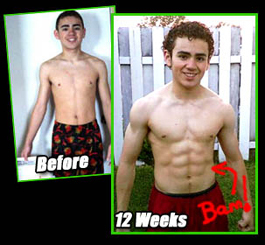For a lot of guys, flipping through your typical muscle magazine is not inspiring and motivational, but rather, it's frustrating or even depressing. Why? Because despite following the advice, trying out the latest "guaranteed to build bulk" training routine and gobbling down buckets of the hottest new supplements, they hardly look any different from when they started. You see, the guys they show in the magazines are professional bodybuilders, athletes or fitness models. In any case, what you're seeing are guys who are for the most part, genetically-gifted. And remember, these guys make up a very small percentage of the population.
So what's an ordinary guy to do if he wants to see results?
A good place to start would be to take a close look at the Hardgainer Project X (HPX) Program, developed by renowned trainer and "muscle nerd" Jeff Anderson. Jeff's program is focused entirely on helping the guys for whom gaining muscle mass is a seemingly impossible task. He's made a career out of helping the endomorph-aka the hardgainer-to jumpstart growth and realize great gains in size and strength.
Jeff opens with a worthwhile presentation of useful information that helps you to understand the inherent difficulties that block hardgainers' progress in achieving results. By itself, the section, 7 Reasons Your Hardgainer Genetics Suck, makes this a valuable read. In ordinary language, Jeff explains some of the most common reasons why hardgainers don't get the results they'd like. This is an important part of the book because by understanding the obstacles, it sets the stage for overcoming them.
The next section covers proper nutrition for the hardgainer. Like the section before, Jeff manages to provide a lot of scientific information in everyday language that makes it easy to grasp and understand. The chapter is very thorough, covering important topics such as insulin, the glycemic index, proteins, carbs, the different types of fats and proper nutrition timing.
I think that by helping the reader to understand the science behind the concepts he's presenting, Jeff is increasing the likelihood that they will follow through with the program. Proper nutrition for weightlifting-especially if you're a hardgainer-is not as simple as "high protein/low carbs." In this chapter Jeff clearly lays out everything a hardgainer needs to know about nutrition. He presents strategies for keeping the body in the "anabolic zone" so it is in a constant muscle-building mode.
In the chapters that follow, Jeff launches into workouts that are specifically designed to help the hardgainer to put on mass. First though, as he does in the previous chapters he starts out by helping the reader to gain a basic-but thorough-understanding of some principles. Here, he covers training frequency, training session length, the selection of exercises, the number of sets and lastly, timing your training. Training frequency is one area where the HPX workout contrasts with what you're likely to see in a lot of the routines that you see in the muscle magazines. Smartly,
HPX calls for only a three-day-a-week workout plan, leaving plenty of time for recovery-which is when the real muscle building happens.
HPX uses a unique two-phase approach that Jeff refers to as Neuromuscular Activation and Neuromuscular Bridging. Jeff says that the first phase is to "wake up" the central nervous system and get it into the muscle-building mode. There are two steps to this-Core Stabilization and Neuromuscular Activation (NMA) Supersets. Core Stabilization is sort of a warm-up and NMA Supersets focus on the lower body.
Phase 2 would be considered the "heart"
of the lifting component of the program.
 Jeff says that his lifting techniques do what other methods don't-address the unique physiology of the hardgainer. In particular, Jeff is talking about the poor nerve-to-muscle connections that are inherent to hardgainers.
Jeff says that his lifting techniques do what other methods don't-address the unique physiology of the hardgainer. In particular, Jeff is talking about the poor nerve-to-muscle connections that are inherent to hardgainers.
To overcome this,
HPX incorporates an interesting modification of the "rest-pause" technique. Another "out of the ordinary" aspect of HPX is that it does not call for training to failure. In fact, Jeff refers to it as "sub-failure" training. This certainly is the opposite of the typical hardgainer workout you see in the magazines. Those workouts call for training to failure-and then some. But if you're a hardgainer, you've probably already tried that and figured out that it just doesn't work for you.
On the whole I think HPX is an excellent book. It's obvious that Jeff knows what he's talking about and that he's done his homework. He's not just regurgitating the same old stuff you see in the muscle magazines-and that's refreshing.
More Information About Muscle Building Click Here
Source 4 Foods Never To Eat

No comments:
Post a Comment